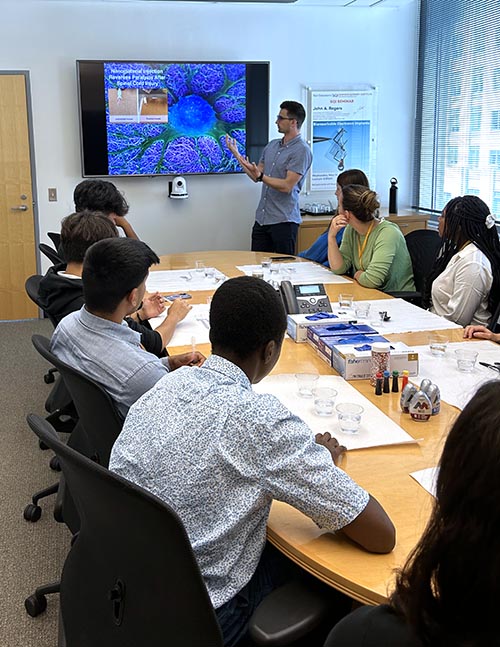SQI hosts high school students interested in medicine
Forty-seven high school students with the National Student Leadership Conference’s (NSLC) Medicine Intensive program visited the Simpson Querrey Institute for BioNanotechnology (SQI) on August 2 to learn about the Institute’s biomedical research and how therapeutic materials are synthesized, analyzed, and ultimately tested in disease models.
The visit included a hands-on demonstration with alginate as an introduction to SQI’s work with biomaterials, tours of the Institute’s core facilities to learn how peptide-based nanomaterials are created and analyzed, and a discussion about how therapies can be tested in lab-grown artificial organs developed from stem cells. A panel of SQI researchers at various career stages also answered questions from the students on a range of topics, including research and career advice.
“It was nice to have the opportunity once again to be a part of this great program after several years of pandemic-related restrictions,” said Mark Karver, Director of the Peptide Synthesis Core Facility and SQI’s primary organizer for the event. “It’s really rewarding to see and interact with such inquisitive young minds interested in science and medicine and to get the chance to tell them a little about what we do here at SQI.”
After introducing the students to SQI’s work with regenerative bionanomaterials, Nick Sather (pictured at right) encouraged them to create their own biomaterials out of alginate, a polymer used in many foods as well as in tissue engineering and drug delivery. The students were challenged to make creative shapes and encapsulate sprinkles into the gel — much like cells can be encapsulated into hydrogels for therapeutic applications. Most of them ate their creations at the end of the activity.
“They definitely had fun with it,” said Sather, SQI’s Associate Director for Translational Research and Technology Transfer. “They were making colored caviar, worms — all sorts of shapes.”
During the lab tours led by Karver and Hiroaki Sai, Acting Director of ANTEC, the students learned about the instrumentation involved with making peptide-based nanomaterials and how the amino acid sequences can be fine-tuned to interact with different cells and tissues. Then they observed how the materials are processed and tested prior to use in biological systems, including freeze-drying and characterization of physical properties.
They also saw time-lapse videos of neurons growing on nanomaterials produced at SQI and learned how 3D artificial organs, called organoids, can be used to study disease mechanisms and test therapies.
“The students were very excited to learn that we can grow human tissues like this in a petri dish,” said Nozomu Takata, a Research Associate who led the organoids demonstration. “They were surprised that these miniature organs are on the order of millimeters when cells are only on the order of microns, which is a huge difference.”
